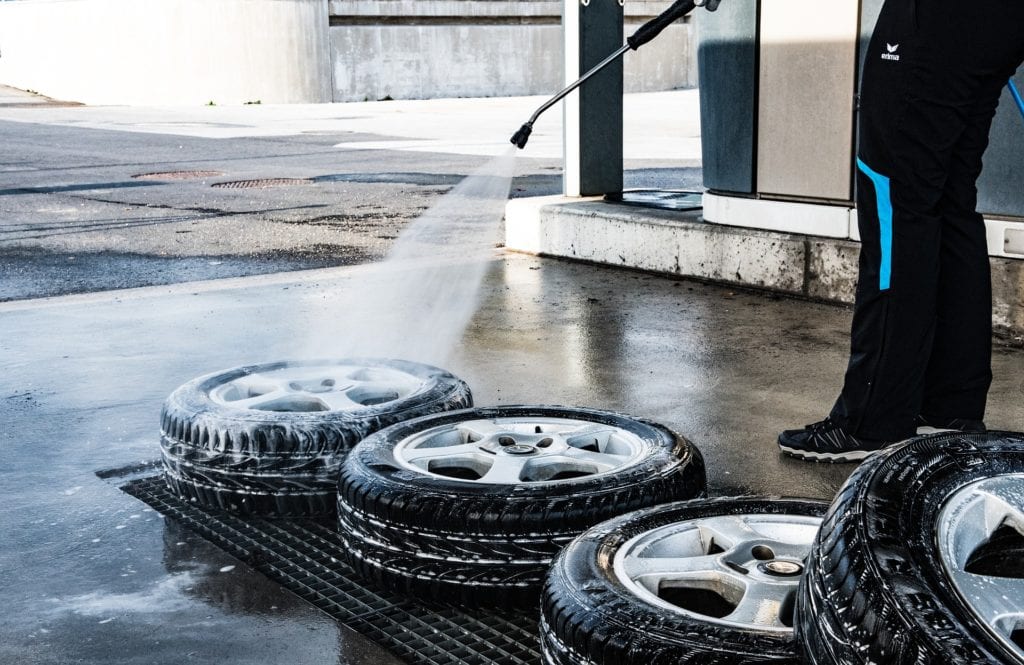
Pressure washing and power washing might seem like synonymous terms at first, but are they really the same? Or is there a difference?
The short answer is even though pressure washing and power washing are similar in many ways, there’s one crucial difference you should always keep in mind.
While it might seem like a rather insignificant difference when you first learn about it, it changes the way each service is performed.
And this means some jobs are better suited to pressure washing, while others are best reserved for power washing!
It can be a little confusing at first, but don’t worry: we’re going to clear everything up for you right here in this guide.
Pressure Washing vs. Power Washing: What’s the Difference?
At the basic level, pressure washing and power washing are incredibly similar. Both create a highly pressurized jet of water that helps quickly remove things like dirt and mold from hard surfaces.
They even use similar pressure levels!
Ultimately, the only significant difference in water pressure will be determined by the type of washer machine you use – a household unit offers less power than industrial models.
The real difference between pressure washers and power washers… is a heating element. You could almost say it’s a matter of hot vs. cold!
Even though it might seem like a rather small difference, the fact a power washer heats up the water actually makes it more suitable for some cleaning tasks than a pressure washer.
Power Washing in a Nutshell
Let’s tackle power washing first.
Power washers include a heating element and use a high-pressure jet of very hot water.
This allows it to blast dirt and other materials from hard, outdoor surfaces with a combination of high water pressure force and temperature.
As a result, power washing is typically the go to choice for removing the kinds of things really stuck to the surface.
For example, power washers are often used to get rid of oil and grease stains on driveways and garage floors, as well as chewing gum from sidewalks.
It’s also great for handling salt residue, mildew, and mold from decks, driveways, patios, and more. Ultimately, any hardy surface heavily saturated with dirt or other undesirable material is a power washer’s domain.
On top of that, power washing can also be used for controlling moss and weeds! The heat and power of the water kills this kind of plant matter and helps prevent them from regrowing as quickly as they usually do.
Of course, when it comes to weeds, the best solution is always to uproot them, even though doing so requires more manual work.
All told, when it comes down to pressure washing vs. power washing, power washing is the more heavy duty option.
Pressure Washing in a Nutshell
Pressure washing tends to be the term most commonly used by most people, as it’s the version we’re all familiar with. Chances are, you’ve already used a pressure washer (or hired someone else to do so) at your home!
As mentioned earlier, there’s no real difference in the water pressure level when comparing pressure washers to power washers. The only meaningful difference is pressure washers don’t feature a heating element, so the water temperature isn’t altered.
This regular water temperature isn’t as effective against tough stains like oil and grease, though it can still help. Mold, moss, and weeds also aren’t as affected by pressure washing as they are by power washing.
Dirt tends to be the pressure washer’s domain.
As a result, pressure washers are typically considered a lighter duty option when compared to power washers. This makes pressure washers a more “general user” friendly choice, especially as a household unit.
Pressure Washing vs. Power Washing: Which Do I Need?

Now that you know what the main differences between pressure washers and power washers are, in terms of mechanical features and general application, it’s time to figure out which of the two is best suited to your needs.
And ultimately, that’s exactly what the deciding factor is going to be!
As explained above, the pressure washing vs. power washing debate is really a question of light duty vs. heavy duty jobs.
Heat – especially at the very high temperatures power washers produce – is quite abrasive. This means even though power washing can be done on wood decks and patios, it isn’t generally recommended.
Wood is a relatively soft material and the combination of high-pressure water and high temperatures can very easily cause permanent damage.
For this reason, power washing is generally recommended for commercial applications only.
So if you have a large commercial space that needs a thorough cleaning – or a very large driveway – then power washing is the way to go. This is especially true for spaces like car parks, mall plazas, mechanics’ workshops, and gas stations.
These areas typically have concrete or (in the case of mall plazas at least) marble or granite surfaces that are better able to handle power washing.
For doing a deep-clean on your home’s outside surfaces (including regular-sized driveways), pressure washing is the way to go instead.
Without the added abrasion caused by high temperatures, the pressure washer is effectively more gentle on brick, masonry, and wood.
A Quick and Dirty Beginner’s Guide
Pressure washers come with different nozzles, which determine the water stream’s angle. Luckily, they’re universally color-coded (though you should still check the user manual to make sure):
- Red – very narrow stream (0 degrees) with the pressure focused in a tight area
- Yellow – 15-degree angle stream, best used on concrete only
- Green – 25-degree angle stream, good for all-purpose cleaning (including deck maintenance)
- White – 40-degree angle stream, a very user-friendly nozzle suitable for cleaning windows and vinyl siding
- Black – 65-degree angle stream too light to have any marked effect for cleaning, but is good for wetting a surface
Whenever you use a pressure washer, make sure to wear ear and eye protection. The last thing you want is to cause hearing loss – and the force of the water means a lot of it, and the dirt particles, will spray back toward you.
Especially when starting out, be safe rather than sorry by holding the pressure washer’s wand with both hands. As you get used to it and gain confidence, you can try using just your dominant hand.
Always keep the nozzle about 18 inches from the surface you’re cleaning.
This way, you reduce the risk of causing damage. Using the right nozzle is always important, but using the whole pressure washer correctly is just as important!
Regardless of the surface you’re cleaning, move the wand in an even, steady motion. For wood especially, start at the end of a board and continue along its entire length to avoid unsightly visible lines. Overlapping passes are your friend here too.
DIY or Hire an Expert?
Regardless of whether you’re using a pressure washer or a power washer, it’s almost always better to hire an expert than to do it yourself. Remember: these tools produce a high-pressure stream of water that can easily damage most surfaces.
Don’t take the chance – hire the best pressure washing company in Northeast Texas. Contact H&H Construction and Renovation today and get started with a quote!
Contact us today and get started!
